Performance and Mechanism of Polycarboxylate Superplasticizer in Red Mud Blended Cementitious Materials
Abstract
1. Introduction
2. Materials and Methods
2.1. Raw Materials
2.2. Synthesis of PCEs
2.3. Preparation of Cement Specimens
2.4. Test
3. Results
3.1. Determination of Saturated Superplasticizer Dosing Points
3.2. Rheological Property Analysis
3.2.1. Setting Time of Red Mud Blended Cement Paste
3.2.2. Influence of Superplasticizers on the Fluidity Loss of Red Mud Blended Cement Paste
3.2.3. Influence of PCE on the Shear Stress of Red Mud Blended Cement Paste
3.2.4. Influence of Superplasticizers on the Apparent Viscosity of Red Mud Blended Cement Paste
3.3. Compressive Strength Analysis
3.4. Mineral Composition Analysis
3.5. Micro-Morphological Analysis
3.6. Thermal Analysis
3.7. Mechanistic Analysis
4. Conclusions
The Primary Conclusions Can Be Drawn as Follows:
- (1)
- At the saturated dosages of WR-PCE and SR-PCE of 0.5% and 0.75%, respectively, the addition of PCEs improved the fluidity of the paste. The SR-PCE-incorporated paste exhibited a lower rate of time-dependent fluidity loss at 30 and 60 min compared to the WR-PCE-incorporated paste. With 0% and 25% red mud contents, the 1-day, 3-day, 7-day, and 28-day compressive strengths for pastes incorporated with WR-PCE and SR-PCE were higher than those of the reference group. This is due to the enhanced hydration reaction of both C2S and C3S facilitated by WR-PCE and SR-PCE, with WR-PCE showing a more pronounced effect.
- (2)
- At 0% and 25% red mud contents, the yield stress of the WR-PCE-incorporated paste approached to near zero, resembling a Newtonian fluid with optimal dispersibility. In contrast, the reference group and the SR-PCE-incorporated paste behaved as Bingham fluids. The plastic viscosity order was as follows: reference group > SR-PCE > WR-PCE. As the red mud content increased, the paste’s shear stress and apparent viscosity increased. When the red mud content reached 50%, all pastes exhibited Bingham fluid characteristics, maintaining the following plastic viscosity order: reference group > SR-PCE > WR-PCE.
- (3)
- In both unincorporated and PCE-incorporated red mud blended cement paste, C-S-H appeared fibrous and network-like, while Ca (OH)2 was flaky. However, the WR-PCE-incorporated paste showed a more even hydration product distribution compared to the SR-PCE-incorporated paste. A high red mud content of 50% negatively affected its strength, likely due to the excessive alkalinity destabilizing the PCE.
Author Contributions
Funding
Data Availability Statement
Acknowledgments
Conflicts of Interest
References
- Wu, P.F.; Liu, X.; Zhang, Z.Q.; Wei, C. Properties of Red Mud-Filled and Modified Resin Composites. Constr. Build. Mater. 2023, 409, 133984. [Google Scholar] [CrossRef]
- Li, Z.F.; Liu, X.L.; Gao, Y.F.; Zhang, J. Study on the Hardening Mechanism of Bayer Red Mud-Based Geopolymer Engineered Cementitious Composites. Constr. Build. Mater. 2023, 392, 131669. [Google Scholar] [CrossRef]
- Hao, X.S.; Liu, X.M.; Zhang, Z.Q.; Zhang, W.; Lu, Y.; Wang, Y.G.; Yang, T.Y. In-Depth Insight into the Cementitious Synergistic Effect of Steel Slag and Red Mud on the Properties of Composite Cementitious Materials. J. Build. Eng. 2022, 52, 104449. [Google Scholar] [CrossRef]
- Zhu, J.G.; Yue, H.Z.; Ma, L.J.; Li, Z.C.; Bai, R. The Synergistic Hydration Mechanism and Environmental Safety of Multiple Solid Wastes in Red Mud-Based Cementitious Materials. Environ. Sci. Pollut. Res. 2023, 30, 79241–79257. [Google Scholar] [CrossRef]
- Liu, Y.; Li, H.; Wang, K.; Wu, H.F.; Cui, B.Q. Effects of Accelerator–Water Reducer Admixture on Performance of Cemented Paste Backfill. Constr. Build. Mater. 2020, 242, 118187. [Google Scholar] [CrossRef]
- Wu, Y.H.; Li, Q.Q.; Li, G.X.; Tang, S.Y.; Niu, M.D.; Wu, Y.F. Effect of Naphthalene-Based Superplasticizer and Polycarboxylic Acid Superplasticizer on the Properties of Sulfoaluminate Cement. Materials 2021, 14, 662. [Google Scholar] [CrossRef]
- Sha, S.N.; Wang, M.; Shi, C.J.; Xiao, Y.C. Influence of the Structures of Polycarboxylate Superplasticizer on Its Performance in Cement-Based Materials-a Review. Constr. Build. Mater. 2020, 233, 117257. [Google Scholar] [CrossRef]
- Zhao, F.H.; Yin, G.J.; Zang, F.Z.; Li, Y.P.; Zhang, H.X. Study on adsorption behavior of water reducer in cement-based materials. World Build. Mater. 2011, 32, 9–12. [Google Scholar]
- Flatt, R.J.; Schober, I.; Raphael, E.; Plassard, C.; Lesniewska, E. Conformation of Adsorbed Comb Copolymer Dispersants. Langmuir 2009, 25, 845–855. [Google Scholar] [CrossRef]
- Yoshioka, K.; Tazawa, E.; Kawai, K.; Enohata, T. Adsorption Characteristics of Superplasticizers on Cement Component Minerals. Cem. Concr. Res. 2002, 32, 1507–1513. [Google Scholar] [CrossRef]
- Yamada, K.; Takahashi, T.; Hanehara, S.; Matsuhisa, M. Effects of the Chemical Structure on the Properties of Polycarboxylate-Type Superplasticizer. Cem. Concr. Res. 2000, 30, 197–207. [Google Scholar] [CrossRef]
- Feng, H.; Feng, Z.J.; Wang, W.S.; Deng, Z.L.; Zheng, B.C. Impact of Polycarboxylate Superplasticizers (PCEs) with Novel Molecular Structures on Fluidity, Rheological Behavior and Adsorption Properties of Cement Mortar. Constr. Build. Mater. 2021, 292, 123285. [Google Scholar] [CrossRef]
- Marchon, D.; Boscaro, F.; Flatt, R.J. First Steps to the Molecular Structure Optimization of Polycarboxylate Ether Superplasticizers: Mastering Fluidity and Retardation. Cem. Concr. Res. 2019, 115, 116–123. [Google Scholar] [CrossRef]
- Zhang, Q.Q.; Shu, X.; Yu, X.H.; Yang, Y.; Ran, Q.P. Toward the Viscosity Reducing of Cement Paste: Optimization of the Molecular Weight of Polycarboxylate Superplasticizers. Constr. Build. Mater. 2020, 242, 117984. [Google Scholar] [CrossRef]
- Lin, X.J.; Liao, B.; Zhang, J.F.; Li, S.M.; Huang, J.H.; Pang, H. Synthesis and Characterization of High-Performance Cross-Linked Polycarboxylate Superplasticizers. Constr. Build. Mater. 2019, 210, 162–171. [Google Scholar] [CrossRef]
- Wei, F.; François, S.; Jutta, R.; Laure, R.; Angélique, V.; Bruno, B.; Nicolas, L. A New Class of Organosilane-Modified Polycarboxylate Superplasticizers with Low Sulfate Sensitivity. Cem. Concr. Res. 2012, 42, 166–172. [Google Scholar] [CrossRef]
- Sun, Z.P. Six Urgent Problems in the Further Study on Polyearboxylate Based Plasticizers. J. Build. Mater. 2020, 23, 128–129. [Google Scholar]
- Zhou, J.; Yang, R.; Wang, Z.Y.; Xie, G.M. Preparation and Properties of VPEG-Viscosity-Reducing Polycarboxylate Superplasticizer. J. Funct. Mater. 2023, 54, 11221–11229. [Google Scholar] [CrossRef]
- Dong, J.T.; Li, Z.Y.; Hu, Z.S.; Zhu, D.D.; Ding, Y.; Zhang, W.Q.; Lai, F.K. Synthesis and Properties of Water Reducing and Slump Protecting Polycarboxylate Superplasticizer. Bull. Chin. Ceram. Soc. 2024, 43, 52–60. [Google Scholar] [CrossRef]
- Gao, H.M.; Sun, Y.L.; Hu, Z.H.; Yang, G.; Wu, W.X. Study on Synthesis and Properties of EPEG Slump Retention Type Polycarboxylate Superplasticizer. New Build. Mater. 2023, 50, 113–117. [Google Scholar]
- Ren, J.; Wang, X.F.; Xu, S.Y.; Fang, Y.H.; Liu, W.; Luo, Q.L.; Han, N.X.; Xing, F. Effect of Polycarboxylate Superplasticisers on the Fresh Properties of Cementitious Materials Mixed with Seawater. Constr. Build. Mater. 2021, 289, 123143. [Google Scholar] [CrossRef]
- Shao, Y.; Jiang, M.M.; Xiong, J.C.; Guo, H.J.; Chen, K.; Liu, Z.H.; Xu, X.M.; Hu, G.F. Nfluence of Admixtures on Strength and Hydration Performance of Steel Slag & Desulfurization Ash Based Cementitious Materials. Environ. Eng. 2022, 40, 134–141. [Google Scholar] [CrossRef]
- GB/T 1346-2011; Test methods for water requirement of normal consistency, setting time andsoundness of the portland cement. China Standards Press: Beijing, China, 2011.
- GB/T 8077-2023; Methods for testing uniformityof concrete admixture. China Standards Press: Beijing, China, 2023.
- Shui, L.L.; Yang, H.J.; Sun, Z.P.; He, Y.; Zeng, W.B. Research Progresson Working Mechanism of Polycarboxylate Superplasticizer. J. Build. Mater. 2020, 23, 64–69. [Google Scholar]
- Zingg, A.; Winnefeld, F.; Holzer, L.; Pakusch, J.; Becker, S. Interaction of Polycarboxylate-Based Superplasticizers with Cements Containing Different C3A Amounts. Cem. Concr. Compos. 2009, 31, 153–162. [Google Scholar] [CrossRef]
- Liang, Q. Study on the Synthesis of Polycarboxylated Superplasticizers and Its Compatibility with Cement. Master’s Thesis, North University of China, Taiyuan, China, 2014. [Google Scholar]
- Ma, B.G.; Yang, H.; Tan, H.B.; Dai, Z.D. Adsorption Characteristics of Different Superplasticizers on Cement and Clayminerals. J. Chin. Ceram. Soc. 2013, 41, 328–333. [Google Scholar]
- Lai, G.H.; Liu, X.; Song, X.F.; Guan, J.N.; Wang, Z.M.; Cui, S.P.; Qian, S.S.; Luo, Q.F.; Xie, H.; Xia, C.L. A Mechanistic Study on the Effectiveness of Star-like and Comb-like Polycarboxylate Superplasticizers in Cement Pastes. Cem. Concr. Res. 2024, 175, 107389. [Google Scholar] [CrossRef]
- Lv, J.; Li, X.G.; Qu, G.L.; Wang, L.Y.; Wang, H. Synthesis and Performance Study of Slump-Preserving Polycarboxylic Acid Water Reducing Agent. Technol. Dev. Chem. Ind. 2023, 52, 7–11. [Google Scholar]
- Wu, C.D.; Li, G.L.; Fang, Y.H.; Chen, Z.H.; Lai, G.X.; Chuang, P.H. Synthesis of Early Strength Polycarboxylate Superplasticizer for Precast Concrete and Study on Its Early-Strength Mechanism. IOP Conf. Ser. Earth Environ. Sci. 2019, 358, 032015. [Google Scholar] [CrossRef]
- Chen, J.G.; Zhu, Y.L.; Du, W.L.; Li, M.X.; Wang, Y.F.; Zhang, C.L.; Shi, M.S.; Xue, B.H. Influence of Polycarboxylate Superplasticizer on the Properties of Cement-Fly Ash Cementitious Materials and Concrete. Sustainability 2022, 14, 13440. [Google Scholar] [CrossRef]
- Li, Y. Research on Road Use Technology of Industrial Waste Residue Red Mud. Master’s Thesis, Chongqing Jiaotong University, Chongqing, China, 2022. [Google Scholar]
- Kim, T.H.; Kuppusamy, M.; Velmurugan, K.; Park, S.D.; Kim, S.W.; Park, S.S.; Kim, W.J. Study of CO2 Absorption by Cement Paste Containing Amine Compounds: A Comparative Study of Diethylamine, Dimethylamine and Isopropylamine. Innov. Infrastruct. Solut. 2025, 10, 15. [Google Scholar] [CrossRef]
- Boumaaza, M.; Huet, B.; Turcry, P.; Aït-Mokhtar, A. The CO2-Binding Capacity of Synthetic Anhydrous and Hydrates: Validation of a Test Method Based on the Instantaneous Reaction Rate. Cem. Concr. Res. 2020, 135, 106113. [Google Scholar] [CrossRef]
- Ye, G.; Schutter, G.D.; Poppe, A.M.; Taerwe, L. Influence of Limestone Powder Used as Filler in SCC on Hydration and Microstructure of Cement Pastes. Cem. Concr. Compos. 2007, 29, 94–102. [Google Scholar] [CrossRef]
- Pan, X.Y.; Shi, C.J.; Farzadnia, N.; Hu, X.; Zheng, J.L. Properties and Microstructure of CO2 Surface Treated Cement Mortars with Subsequent Lime-Saturated Water Curing. Cem. Concr. Compos. 2019, 99, 89–99. [Google Scholar] [CrossRef]
- Wang, X.; Ni, W.; Li, J.J.; Zhang, S.Q.; Hitch, M.; Pascual, R. Carbonation of Steel Slag and Gypsum for Building Materials and Associated Reaction Mechanisms. Cem. Concr. Res. 2019, 125, 105893. [Google Scholar] [CrossRef]
- Song, Z.B.; Yao, Y.; Li, T.; Li, X.N.; Wu, M.H. Molecular Structure Design and Preparation of Slow Release Polyearboxylie Superplasticizer. J. Build. Mater. 2017, 20, 563–568. [Google Scholar] [CrossRef]
- Erdogdu, S. Compatibility of Superplasticizers with Cements Different in Composition. Cem. Concr. Res. 2000, 30, 767–773. [Google Scholar] [CrossRef]
- Sheng, Y.H.; Li, G.B.; Jiang, H.Q. Effects of Superplasticizers and Fly Ash on Rheological Properties of Cemented Tailings Backfill. J. Chongqing Univ. 2020, 43, 55–63. [Google Scholar] [CrossRef]
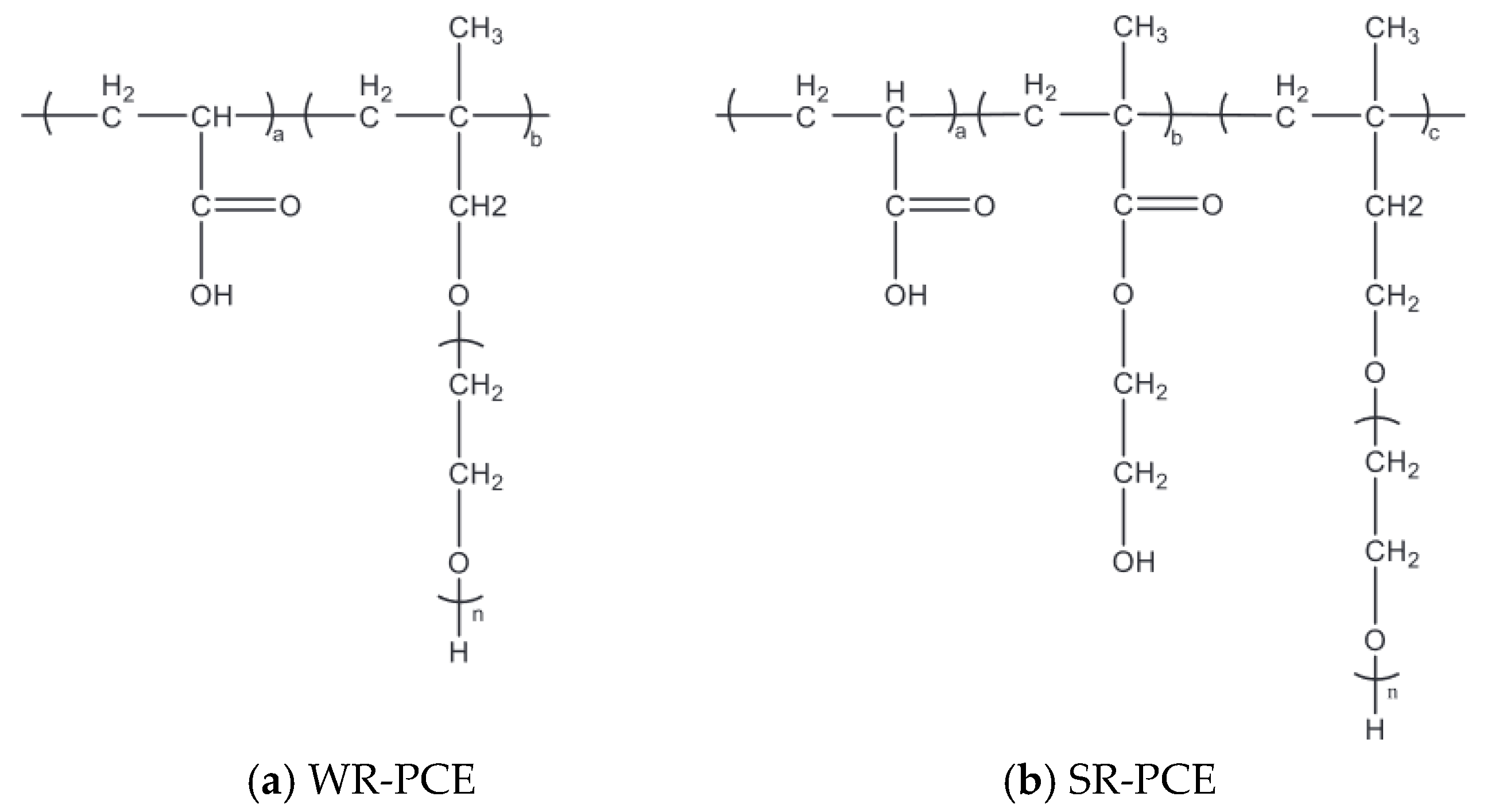
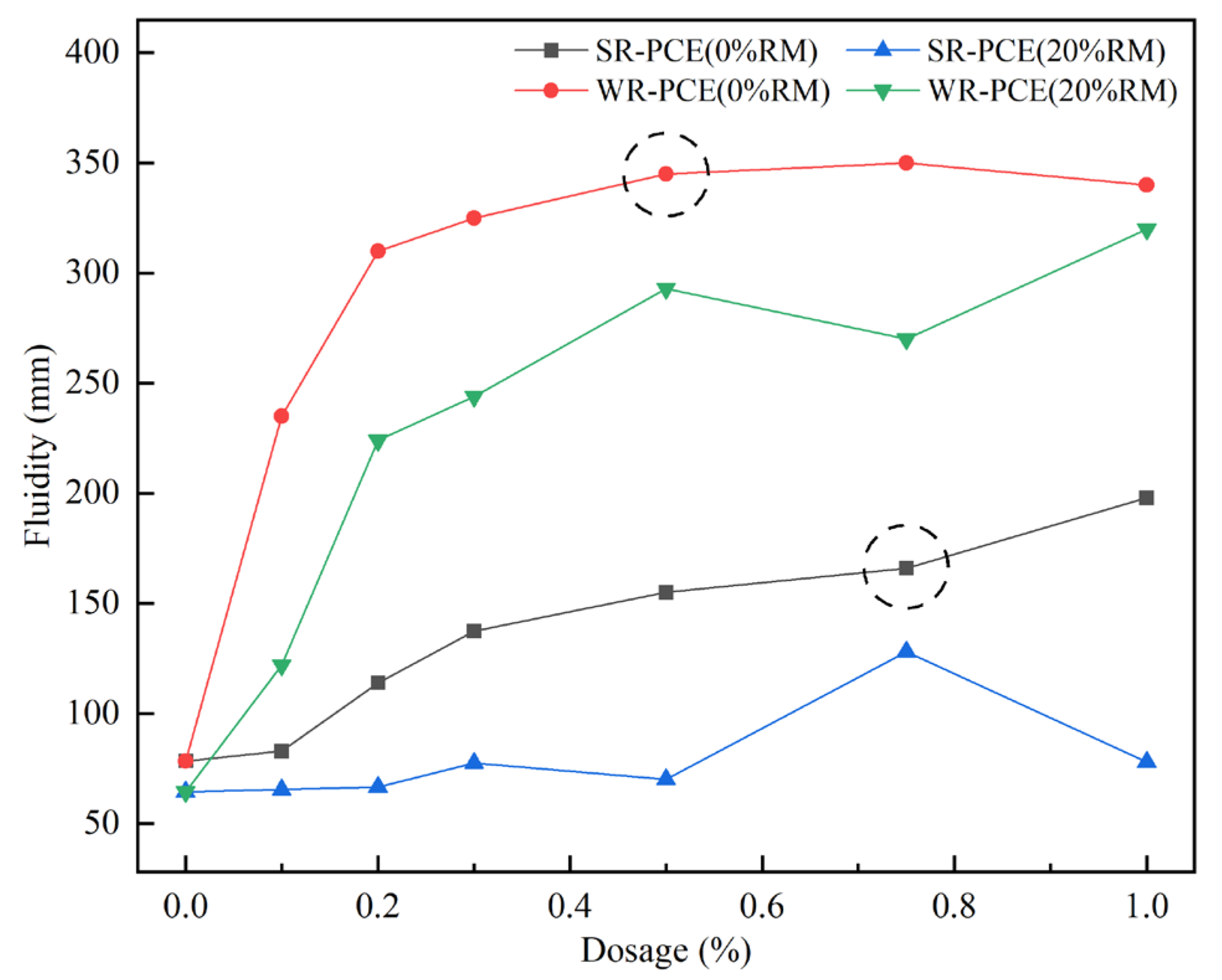

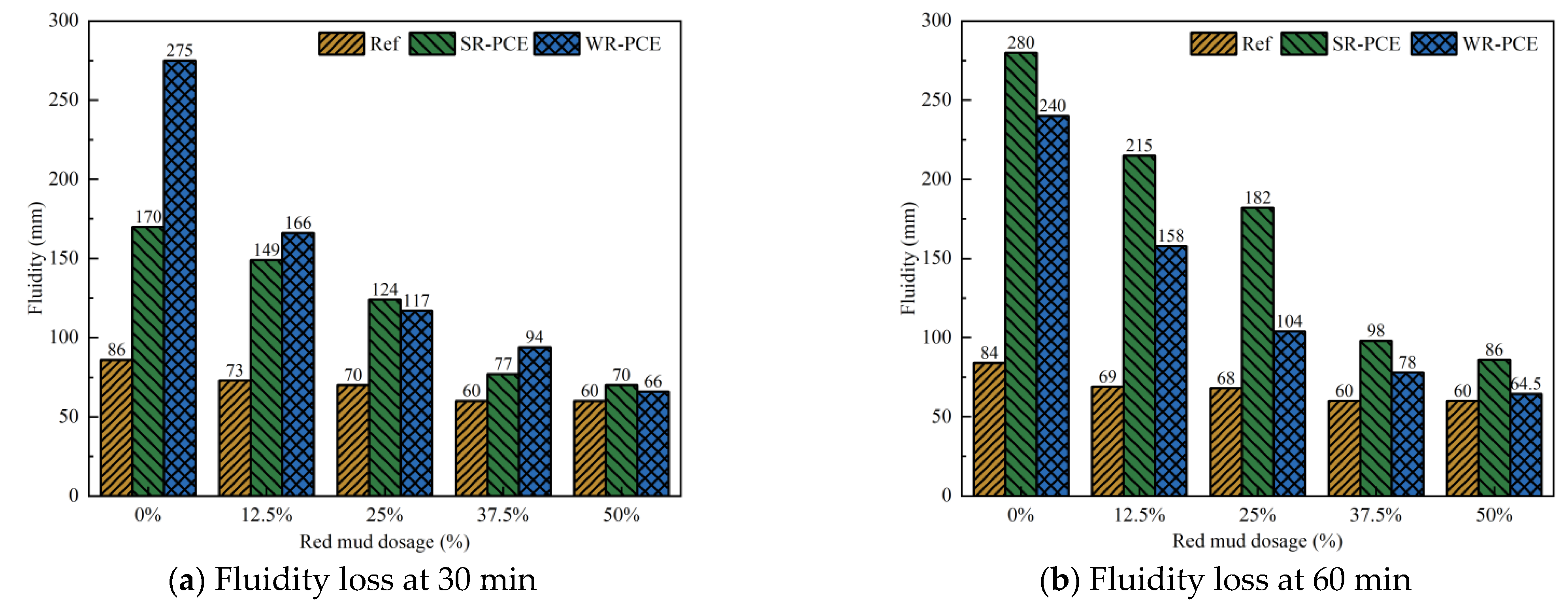
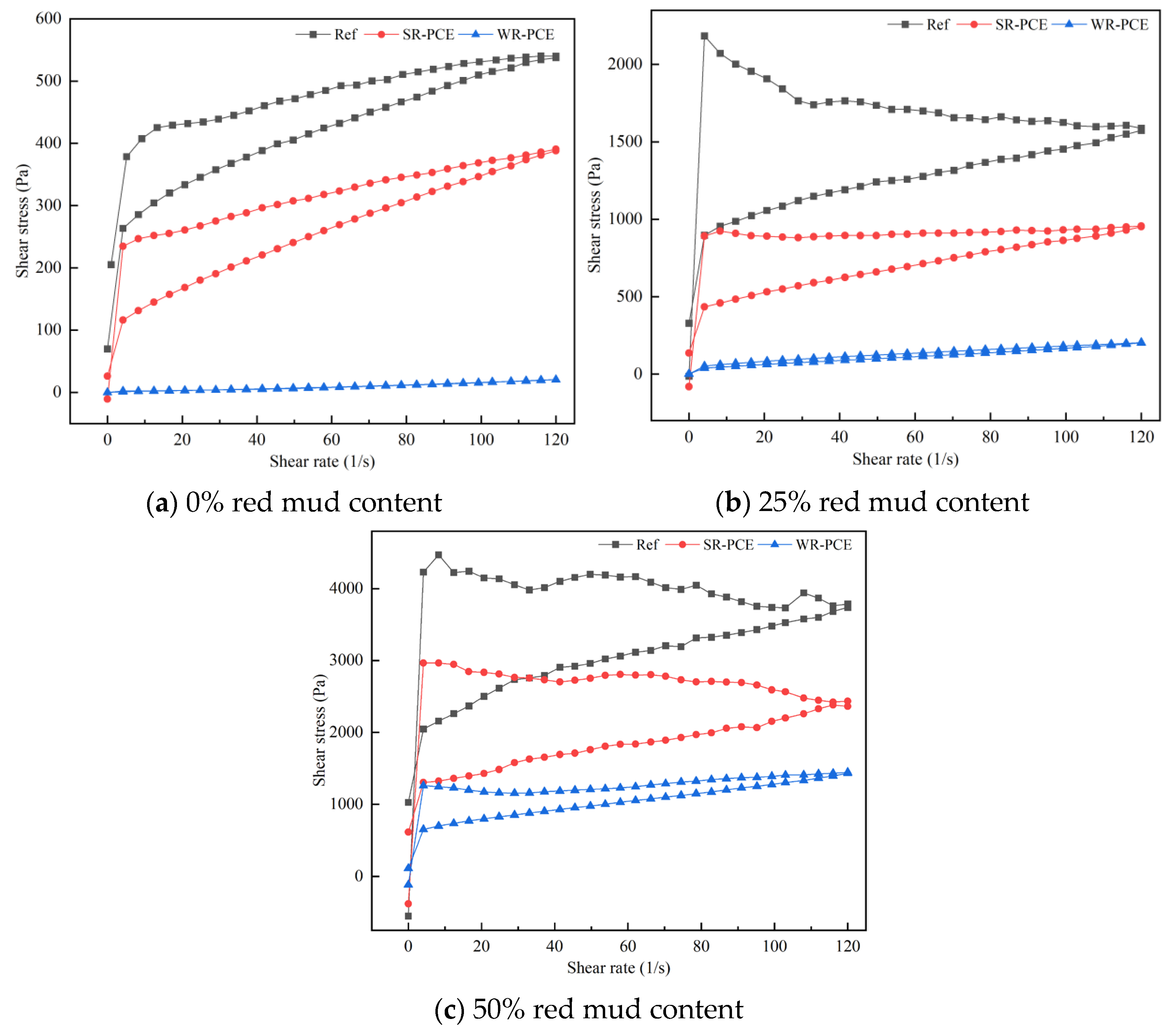
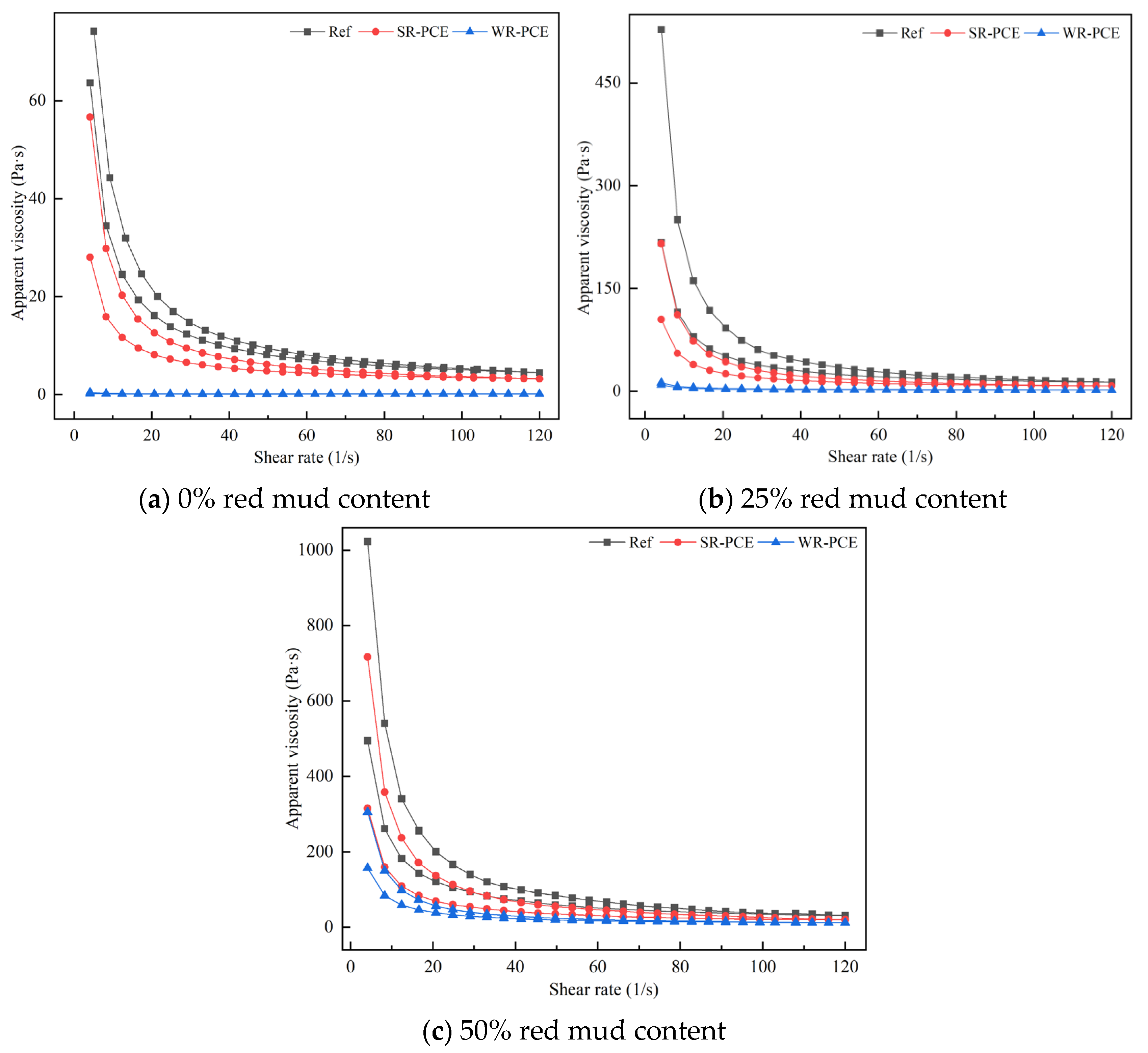


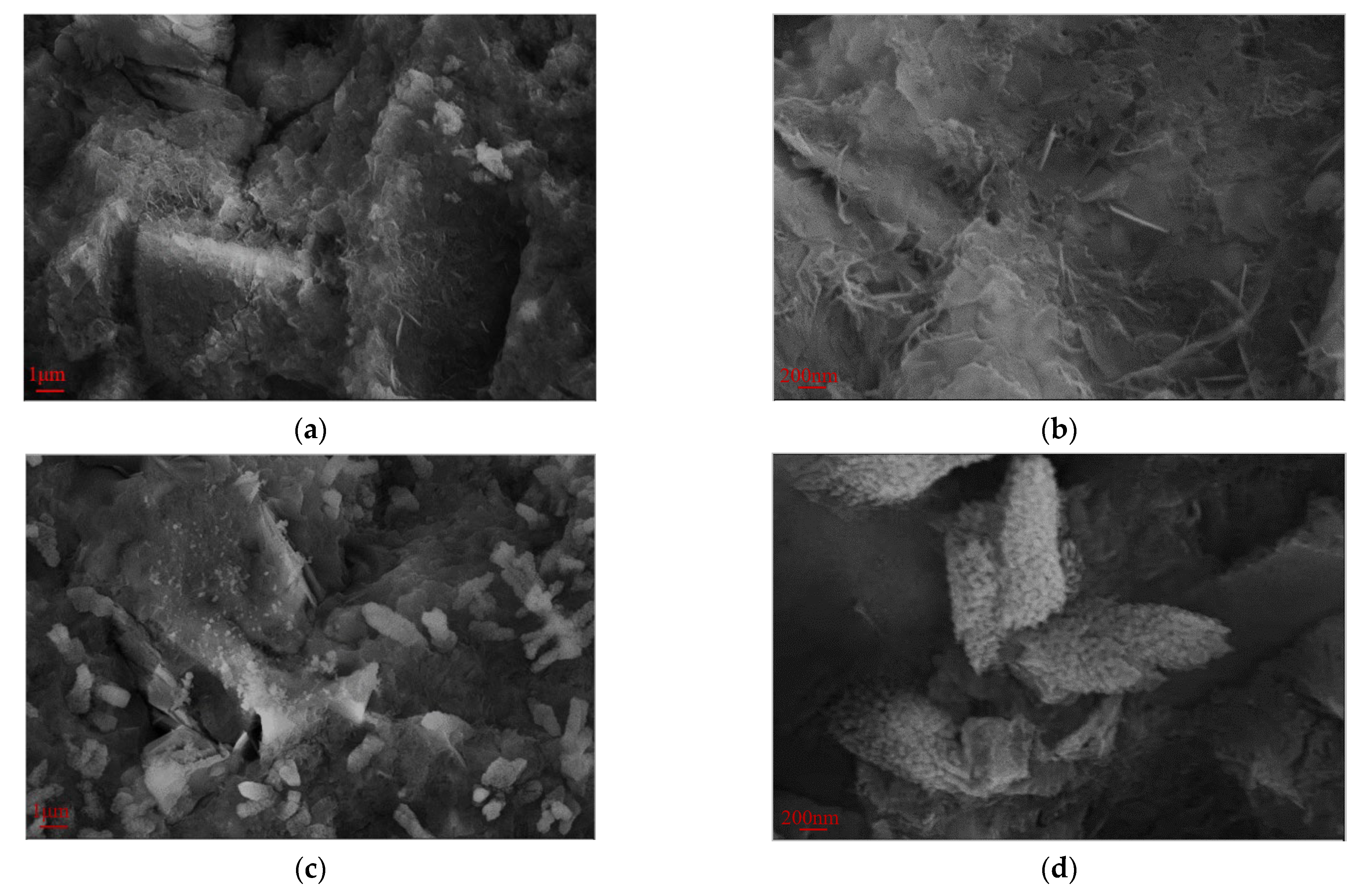

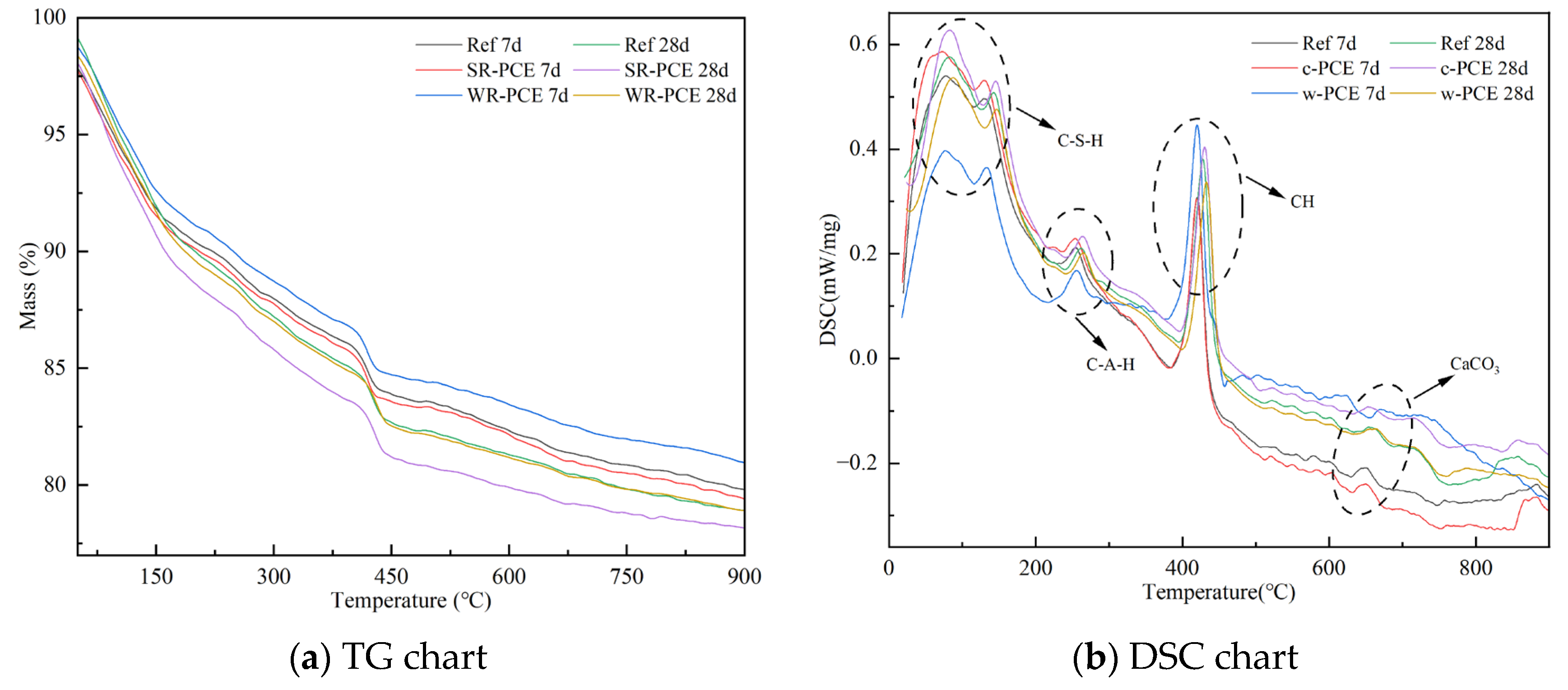
| Raw Material | SiO2 | MgO | Al2O3 | CaO | Fe2O3 | K2O | Na2O | LOI |
|---|---|---|---|---|---|---|---|---|
| Cement | 21.75 | 3.76 | 5.57 | 63.62 | 4.07 | 0.33 | 0.07 | - |
| Red mud | 20.32 | 0.70 | 23.38 | 11.63 | 16.35 | 0.62 | 7.24 | 14.25 |
| Red Mud | Time (min) | 12.5% | 25.0% | 37.5% | 50.0% |
|---|---|---|---|---|---|
| PCE | |||||
| SR-PCE | 30 | 12.4% | 27.1% | 54.7% | 58.8% |
| WR-PCE | 30 | 39.6% | 57.5% | 65.8% | 76.0% |
| SR-PCE | 60 | 23.2% | 35.0% | 66.4% | 69.2% |
| WR-PCE | 60 | 34.2% | 56.7% | 67.5% | 73.1% |
| Yield Stress/Pa (Red Mud 0%) | Yield Stress/Pa (Red Mud 25%) | Yield Stress/Pa (Red Mud 50%) | |
|---|---|---|---|
| Ref | 69.678 | 327.730 | 1026.300 |
| SR-PCE | 26.193 | 136.780 | 612.500 |
| WR-PCE | 0.015 | 1.811 | 112.660 |
| Plastic Viscosity/Pa·s (Red Mud 0%) | Plastic Viscosity/Pa·s (Red Mud 25%) | Plastic Viscosity/Pa·s (Red Mud 50%) | |
|---|---|---|---|
| Ref | 4.499 | 13.228 | 31.548 |
| SR-PCE | 3.254 | 7.966 | 20.288 |
| WR-PCE | 0.172 | 1.697 | 12.050 |
| Curing Time (d) | Stage I | Stage II | Stage III | Total Loss | |
|---|---|---|---|---|---|
| Ref | 7 | 2.7% | 5.7% | 5.2% | 18.4% |
| SR-PCE | 7 | 3.3% | 4.8% | 5.4% | 19.0% |
| WR-PCE | 7 | 4.7% | 4.3% | 5.3% | 19.5% |
| Ref | 28 | 3.5% | 5.2% | 5.5% | 19.6% |
| SR-PCE | 28 d | 4.4% | 4.6% | 5.0% | 20.2% |
| WR-PCE | 28 d | 5.2% | 4.0% | 4.1% | 20.9% |
Disclaimer/Publisher’s Note: The statements, opinions and data contained in all publications are solely those of the individual author(s) and contributor(s) and not of MDPI and/or the editor(s). MDPI and/or the editor(s) disclaim responsibility for any injury to people or property resulting from any ideas, methods, instructions or products referred to in the content. |
© 2025 by the authors. Licensee MDPI, Basel, Switzerland. This article is an open access article distributed under the terms and conditions of the Creative Commons Attribution (CC BY) license (https://creativecommons.org/licenses/by/4.0/).
Share and Cite
Yang, L.; Wang, P.; Luo, S.; Wang, Y.; Xu, S. Performance and Mechanism of Polycarboxylate Superplasticizer in Red Mud Blended Cementitious Materials. Polymers 2025, 17, 1738. https://doi.org/10.3390/polym17131738
Yang L, Wang P, Luo S, Wang Y, Xu S. Performance and Mechanism of Polycarboxylate Superplasticizer in Red Mud Blended Cementitious Materials. Polymers. 2025; 17(13):1738. https://doi.org/10.3390/polym17131738
Chicago/Turabian StyleYang, Lei, Pengfei Wang, Shuqiong Luo, Yaxin Wang, and Shengye Xu. 2025. "Performance and Mechanism of Polycarboxylate Superplasticizer in Red Mud Blended Cementitious Materials" Polymers 17, no. 13: 1738. https://doi.org/10.3390/polym17131738
APA StyleYang, L., Wang, P., Luo, S., Wang, Y., & Xu, S. (2025). Performance and Mechanism of Polycarboxylate Superplasticizer in Red Mud Blended Cementitious Materials. Polymers, 17(13), 1738. https://doi.org/10.3390/polym17131738







